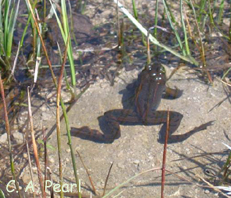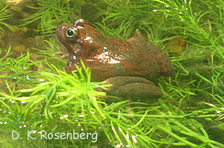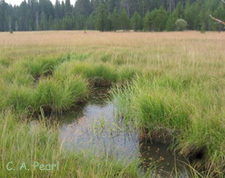 The Oregon spotted frog (Rana pretiosa) is a highly aquatic frog found in shallow, quiet water with moderate vegetation cover. It uses warm shallow flooded areas for oviposition and spends the winters in springs, deep pools, or similar habitat. The Oregon spotted frog was distributed from northern California to British Columbia, but is no longer found in California and it is now absent from many historical sites. It is listed as a Candidate species for listing under the Endangered Species Act by the U.S. Fish and Wildlife Service. Many former populations appear to have disappeared, and remaining populations throughout Oregon, Washington, and British Columbia are threatened by introduced fish and bullfrogs, invasive vegetation, development, changes in hydrology, and possibly disease. The Oregon Wildlife Institute is embarking on new conservation planning efforts to help stop the loss of this species.
The Oregon spotted frog (Rana pretiosa) is a highly aquatic frog found in shallow, quiet water with moderate vegetation cover. It uses warm shallow flooded areas for oviposition and spends the winters in springs, deep pools, or similar habitat. The Oregon spotted frog was distributed from northern California to British Columbia, but is no longer found in California and it is now absent from many historical sites. It is listed as a Candidate species for listing under the Endangered Species Act by the U.S. Fish and Wildlife Service. Many former populations appear to have disappeared, and remaining populations throughout Oregon, Washington, and British Columbia are threatened by introduced fish and bullfrogs, invasive vegetation, development, changes in hydrology, and possibly disease. The Oregon Wildlife Institute is embarking on new conservation planning efforts to help stop the loss of this species.
Willamette Valley Project
 Although Oregon spotted frogs once occurred in the vast wetlands of the Willamette Valley, lack of recent documented sightings prompted public agencies to consider the species as “extirpated” from the Valley. The Oregon Wildlife Institute, with collaborators from Washington Department of Fish and Wildlife and USGS, explored the feasibility of identifying potentially suitable habitat to search for remnant populations. Our detailed report provides the rationale for conducting strategic surveys to discover remnant populations. Locating remnant populations, translocations, and reintroductions have been an important part of the recovery of Oregon spotted frogs. Reintroductions have been taking place in Washington, partially aided by captive rearing of Oregon spotted frogs at the Oregon Zoo.
Although Oregon spotted frogs once occurred in the vast wetlands of the Willamette Valley, lack of recent documented sightings prompted public agencies to consider the species as “extirpated” from the Valley. The Oregon Wildlife Institute, with collaborators from Washington Department of Fish and Wildlife and USGS, explored the feasibility of identifying potentially suitable habitat to search for remnant populations. Our detailed report provides the rationale for conducting strategic surveys to discover remnant populations. Locating remnant populations, translocations, and reintroductions have been an important part of the recovery of Oregon spotted frogs. Reintroductions have been taking place in Washington, partially aided by captive rearing of Oregon spotted frogs at the Oregon Zoo.
Sponsor: Oregon Zoo
Jack Creek Site Management Plan
 In conjunction with the U.S. Forest Service, the Oregon Wildlife Institute developed a site management plan for this population of frogs within the Klamath Basin. The site is a mix of public and private ownership, and has been used for summer cattle grazing for the last century. The Oregon Wildlife Institute identified potential management actions to improve habitat and restore the site’s hydrology, and provided guidance for appropriate grazing strategies if cattle grazing continues to be conducted in the Jack Creek system.
In conjunction with the U.S. Forest Service, the Oregon Wildlife Institute developed a site management plan for this population of frogs within the Klamath Basin. The site is a mix of public and private ownership, and has been used for summer cattle grazing for the last century. The Oregon Wildlife Institute identified potential management actions to improve habitat and restore the site’s hydrology, and provided guidance for appropriate grazing strategies if cattle grazing continues to be conducted in the Jack Creek system.
Sponsor: Interagency Special Status/Sensitive Species Program (US Forest Service and Bureau of Land Management)